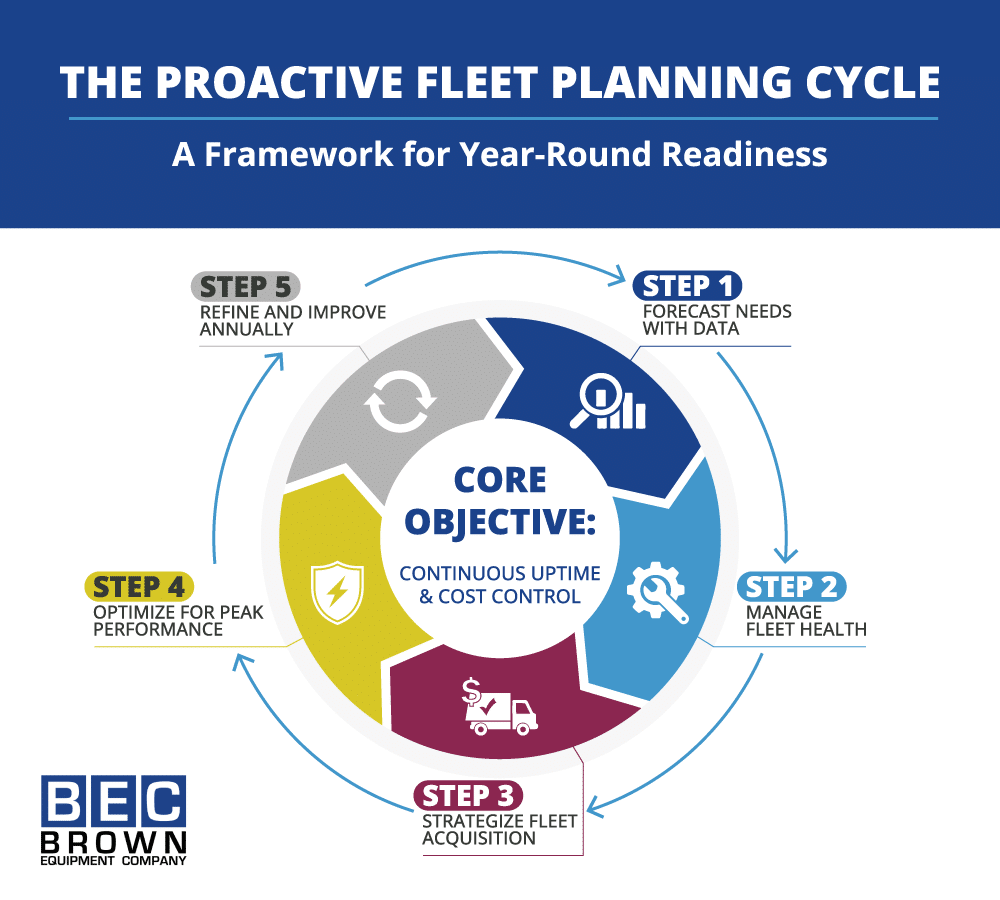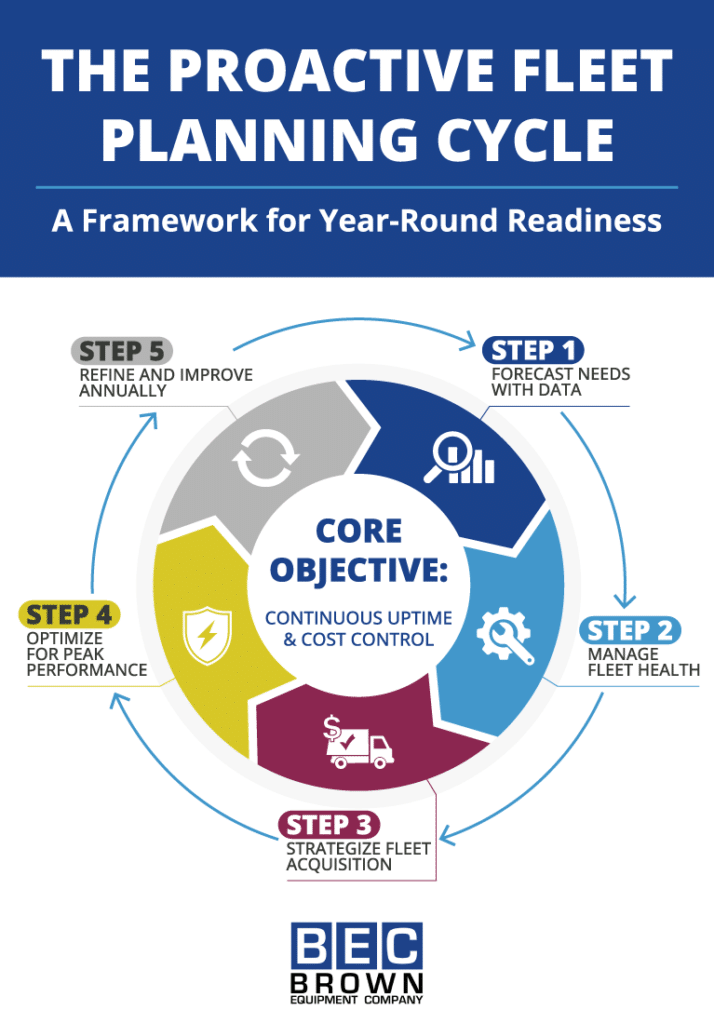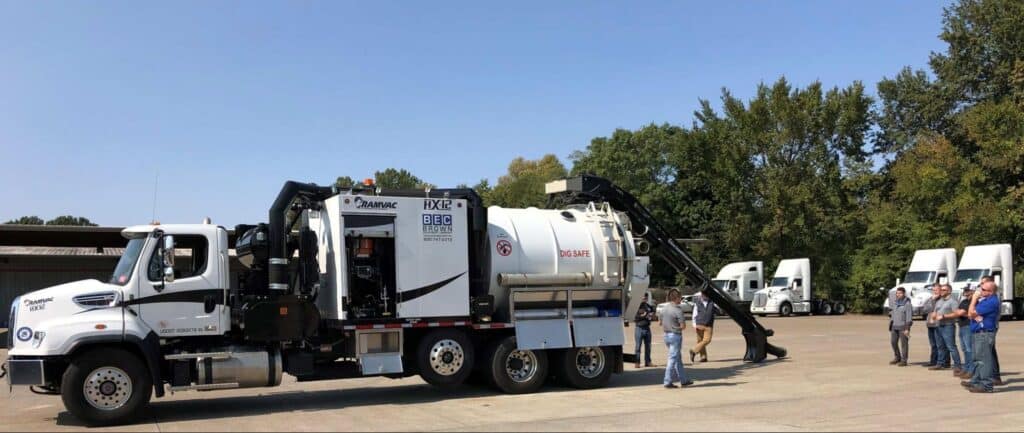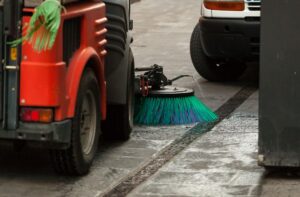For municipalities and large contractors, the shift between seasons brings more than just a change in weather—it brings a fundamental change in operational demands. From clearing snow and maintaining roads in winter to managing large-scale landscaping projects in summer, each season presents unique challenges. Without a well-crafted plan, this fluctuation can lead to budget overruns, critical equipment shortages, and unexpected downtime during peak periods.
Effective seasonal planning is the solution, but it’s more than simply stocking up on equipment. It is a strategic approach that aligns your assets, budget, and resources with these fluctuating demands, helping you overcome common challenges like financial overruns and unpredictable weather. A proactive plan allows you to control rising costs by minimizing emergency repairs, boost efficiency through timely procurement and deployment, and maximize uptime by keeping your fleet in optimal condition.
This guide offers practical strategies to help you develop a robust seasonal plan, ensuring your organization remains agile, cost-effective, and prepared for whatever the year brings.


Step 1: Forecast Seasonal Demand with Data
The foundation of any cost-effective seasonal plan is an accurate forecast. Instead of reacting to demand, a data-driven approach allows you to anticipate your equipment requirements, align resources with upcoming needs, and prevent wasteful spending. By leveraging historical data, modern technology, and strategic planning, you can move from estimation to precision, ensuring your fleet is ready for whatever the season brings.
Use Data to Drive Your Decisions
Your organization’s own history is your most valuable asset in planning. Analyze past usage patterns and review upcoming project scopes to build a clear picture of your needs. Consider these key data points:
- Historical Usage Reports: Identify trends from previous years. Did a severe winter lead to more salt spreader hours? Did a wet spring increase demand for heavy-duty mowers? This data helps you establish a reliable baseline.
- Long-Range Weather Forecasts: While not perfect, meteorological forecasts can help you adjust your baseline for anticipated changes, such as a milder winter or a drier-than-average summer.
- Upcoming Project Scopes: Review confirmed contracts and municipal service agreements. The scale and requirements of these projects will directly inform your equipment allocation.
Incorporate Predictive Analytics to Anticipate Needs
Go beyond historical data by leveraging modern technology. Predictive analytics software uses your past performance data and machine learning algorithms to forecast potential issues and future needs with greater accuracy. This allows you to:
- Anticipate Maintenance Challenges: Forecast when specific equipment might face issues based on historical trends, allowing you to schedule preemptive service.
- Plan Budgets More Accurately: Move beyond guesswork by using predictive models to allocate funds for fuel, parts, and potential rentals.
- React Swiftly to Performance Issues: Get ahead of unexpected equipment failures, minimizing the downtime that can derail a busy season.
Opt for Multi-Purpose Equipment
Once you have a clear forecast, you can make smarter acquisition decisions. Investing in versatile, multi-functional equipment is a key strategy for reducing overall costs and simplifying storage. A single tractor, for example, can be outfitted with specialized attachments to handle diverse tasks—from winter snow removal with a plow and spreader to summer landscaping with a mower deck and loader. This flexibility protects your budget by ensuring every piece of equipment delivers year-round value and maximizes your return on investment.
Create a Robust Contingency Plan
No forecast is perfect. A well-thought-out contingency plan is the difference between a minor disruption and operational chaos when unexpected challenges arise. Build a buffer into your plan by:
- Maintaining a small inventory of critical, high-failure-rate parts.
- Establishing pre-approved partnerships with rental providers for emergency needs.
- Cross-training operators on multiple pieces of equipment to handle sudden increases in workload.
Step 2: Master Your Fleet’s Lifecycle & Maintenance

Once you’ve forecasted your needs, the next step is to ensure every asset in your fleet is prepared to meet the demand. Strategic lifecycle management is about maximizing the performance, longevity, and value of your equipment—from the day it’s purchased to the day it’s replaced. By combining a proactive maintenance schedule with robust tracking and smart reconditioning, you can minimize downtime, control repair costs, and keep your operations running at peak efficiency.
Prioritize a Proactive Maintenance Schedule
The most expensive repairs are almost always the ones that could have been prevented. Moving from a reactive to a proactive maintenance culture is possibly the single most effective way to avoid costly mid-season breakdowns. This means scheduling thorough inspections and service before the high-demand season begins.
A proactive approach is critical because it helps you:
- Reduce Unexpected Breakdowns: Identify and address wear on critical parts before they fail under pressure.
- Extend Equipment Life: Prevent the excessive wear and tear that shortens an asset’s usable lifespan.
- Improve Operator Safety: Ensure every machine meets the highest operational standards before it’s deployed.
Develop Tailored Maintenance Checklists
Each type of equipment has unique maintenance needs. Developing tailored checklists for each category is the best way to prevent specialized failures and ensure consistent operational readiness. Consider these starting points:
- Snow and Ice Management: Inspect hydraulic systems, replace worn plow blades, and verify all lighting and safety features are functional.
- Landscaping Machinery: Check mower decks, belts, and remote-controlled systems for proper operation and sharpness.
- Roadway Maintenance: Assess street sweepers, asphalt patchers, and traffic control signage for full functionality.
Develop Robust Tracking Practices with Digital Monitoring
You can’t manage what you don’t measure. Recording equipment usage, maintenance milestones, and operator feedback is critical for effective lifecycle management. Modern digital fleet monitoring tools and asset tracking software have made this easier than ever, enabling you to:
- Track Operating Hours and Performance Trends: Pinpoint inefficiencies and identify which machines are being over or underutilized.
- Receive Timely Alerts for Maintenance Needs: Automate your service schedule based on actual usage data, not just a calendar date.
- Incorporate Operator Feedback: Use mobile applications to allow operators to log issues in real-time, providing accurate, on-the-ground insights that prevent minor problems from escalating.
Extend Usability with Strategic Reconditioning
Not every piece of aging equipment needs to be replaced. Reconditioning—an economical process of refurbishing equipment through major repairs, painting, and critical parts replacement—is a highly effective alternative to new purchases. This approach:
- Lowers Overall Capital Costs: Extends the life of your valuable assets for a fraction of the cost of a new machine.
- Maintains Operator Familiarity: Keeps your team working with equipment they already know how to operate safely and efficiently.
- Restores Performance: Brings machinery back to reliable, peak performance, ensuring it can handle the demands of another season.
Taking time during each off-season to identify and schedule candidates for a reconditioning program is a cornerstone of long-term, cost-effective asset management.
Leverage Dealer Expertise
Your equipment dealer can be a powerful strategic partner in your maintenance program. Working with an experienced dealer streamlines these tasks by providing:
- Comprehensive Inspections to spot hidden issues your team might miss.
- Access to high-quality OEM parts and timely upgrades.
- Priority scheduling that prevents your equipment from being stuck in a queue mid-season.
- Guidance on the latest industry best practices to keep your maintenance plan ahead of the curve.
Step 3: Strategize Your Fleet Acquisition (Rent vs. Buy)
With your forecast in hand and a clear picture of your current fleet’s health, the next critical step is to bridge the gap. Your acquisition strategy determines how you fill your operational needs, and it requires a balanced approach that weighs the long-term value of ownership against the flexibility of renting. Making the right choice between capital investment and operational agility is key to a cost-effective seasonal plan.
Explore Cost-Effective Rental Options
For fluctuating seasonal demands and specialized, short-term projects, renting equipment offers unmatched flexibility and financial sense. Instead of tying up capital in a machine that will sit idle for much of the year, renting allows you to access the exact tools you need, precisely when you need them.
Renting is the ideal solution when you need to:
- Avoid Large Capital Expenditures: Preserve your capital for other strategic investments and manage equipment costs as a predictable operational expense.
- Gain Immediate Flexibility: Quickly scale your fleet up or down to adjust to unpredictable weather or sudden spikes in demand.
- Reduce Maintenance and Storage Burdens: Eliminate the costs and logistical headaches of off-season storage, insurance, and maintenance, as many rental agreements include full service support.
For example, during a milder winter, it is far more sensible to rent additional snowplows or salt spreaders than to invest in full ownership. Likewise, specialized tools like hydro excavation equipment can be rented for specific short-term projects, ensuring your resources are never underutilized.
Partner with a Strategic Dealer for Long-Term Ownership
For your core, high-usage equipment, ownership is the clear path to long-term value. The key to a successful purchase, however, lies not just in the machine itself, but in the partner you choose. A strategic equipment dealer does more than sell you equipment; they act as a long-term partner in your fleet’s success, helping you make the right acquisition decisions from the start.
A strong dealer partnership provides:
- Tailored Solutions and Expert Guidance: A reputable dealer invests time in understanding your unique operational needs. They can offer customized recommendations on whether to rent or buy a specific piece of equipment and help you select tools—from sewer jetters to landscaping machinery—that are perfectly suited to your budget and requirements.
- Access to Innovations: Top dealers are your gateway to the latest technology. They can introduce you to modern equipment with increased efficiency and improved safety features, ensuring your fleet remains competitive and future-proof.
- Comprehensive Support: The relationship extends far beyond the initial transaction. A good partner provides ongoing operator training, on-site demonstrations, and the preventive maintenance services and readily available OEM parts that make ownership successful and cost-effective.
This long-term partnership transforms routine transactions into a valuable advisory service, ensuring every acquisition is a strategic investment in your organization’s future.
At Brown Equipment Company, our culture is built around the core values that drive our success: passion, accountability, teamwork, and continuous improvement. Through the BEC Blue initiative, we celebrate our shared values and commitment to putting service first, finding solutions, and holding ourselves accountable.
Watch the video below to learn about the dedication, collaboration, and sense of accomplishment that define the BEC team.
Step 4: Optimize Equipment for Performance & Safety
With your fleet planned, maintained, and strategically acquired, the final step is to optimize each piece of equipment to maximize both performance and operator safety. Standard machinery provides a solid foundation, but tailoring it to your specific seasonal challenges is what transforms a good fleet into a great one. This optimization phase ensures every asset is perfectly suited to its task, boosting productivity while minimizing risk.
Enhance Performance with Custom-Built Modifications
Off-the-shelf equipment is designed for general use, but your operational needs are specific. Custom modifications transform standard machines into specialized, high-performance tools that can significantly boost efficiency for your most common seasonal tasks.
Customizing your equipment allows you to:
- Optimize snow and ice management by adding specialized attachments like wider, more efficient snow-clearing blades or extended-reach salt spreaders for comprehensive road coverage.
- Equip vehicles for specialized tasks like pipeline inspections by installing secure equipment racks, camera mounts, or integrated power sources.
- Adapt to challenging terrain by tailoring mowing solutions with remote-controlled tools for steep highway embankments or hard-to-reach areas.
These modifications ensure that each machine is perfectly configured for its intended use, maximizing its operational efficiency and reducing the need to deploy multiple pieces of equipment for a single job.
Strengthen Operations with Advanced Safety Features
An optimized machine is a safe machine. Integrating robust safety measures and protocols is not just a matter of compliance; it’s a critical investment that protects your operators, the public, and your organization from long-term liabilities.
Strengthen your operations by implementing:
- Enhanced Visibility and Traffic Control: Improve safety in low-light conditions with hazard lights and extra illumination, and manage vehicular flow in work zones with high-visibility reflective signage and barricades.
- Specialized Hazard Protection: Equip sewer operations with dedicated manhole safety gear and adopt advanced fall-protection systems for any tasks requiring work at height.
- Improved Operator Ergonomics: Integrate ergonomic features in control panels and seating to reduce operator fatigue, which in turn improves precision and lowers the risk of accidents during long shifts.
Enhanced safety measures do more than just prevent accidents; they foster a professional work environment where staff can confidently and effectively operate sophisticated machinery.
Step 5: Foster a Culture of Continuous Improvement

A seasonal plan shouldn’t be static. The most effective organizations treat it as a dynamic strategy that improves every year. Create a powerful feedback loop by combining performance data with on-the-ground operator insights. At the end of each season, review what worked and what didn’t. Use these findings to refine maintenance schedules, sharpen future forecasts, and optimize your acquisition strategy for the year ahead. This cycle of planning, measuring, and adapting is the key to long-term operational excellence.
Secure Your Operational Success with Proactive Seasonal Equipment Planning
Effective seasonal equipment planning is more than just a checklist; it’s a strategic, year-round cycle. By following a clear 5-step plan – from forecasting demand and mastering your fleet’s lifecycle to strategically acquiring and optimizing your equipment – you move from a reactive position to one of proactive control. This comprehensive approach is your key to minimizing downtime, controlling costs, and ensuring your operations run smoothly, no matter the season.
Executing this plan requires the right partner. Brown Equipment Company is ready to support every step of your seasonal strategy. With expert guidance in rentals and sales, advanced fleet management tools, and comprehensive maintenance, reconditioning, and custom solutions, we are committed to helping you optimize your fleet and secure a cost-effective future. Reach out today to put your plan into action.



